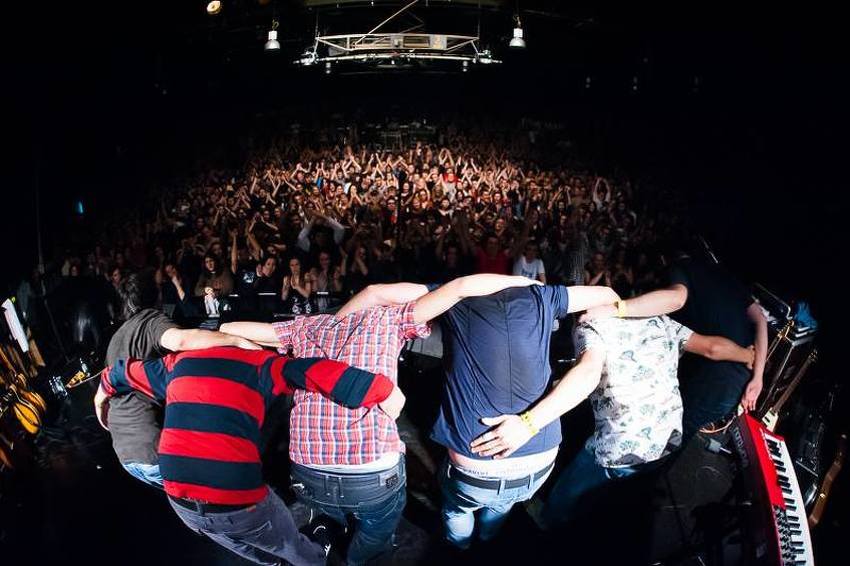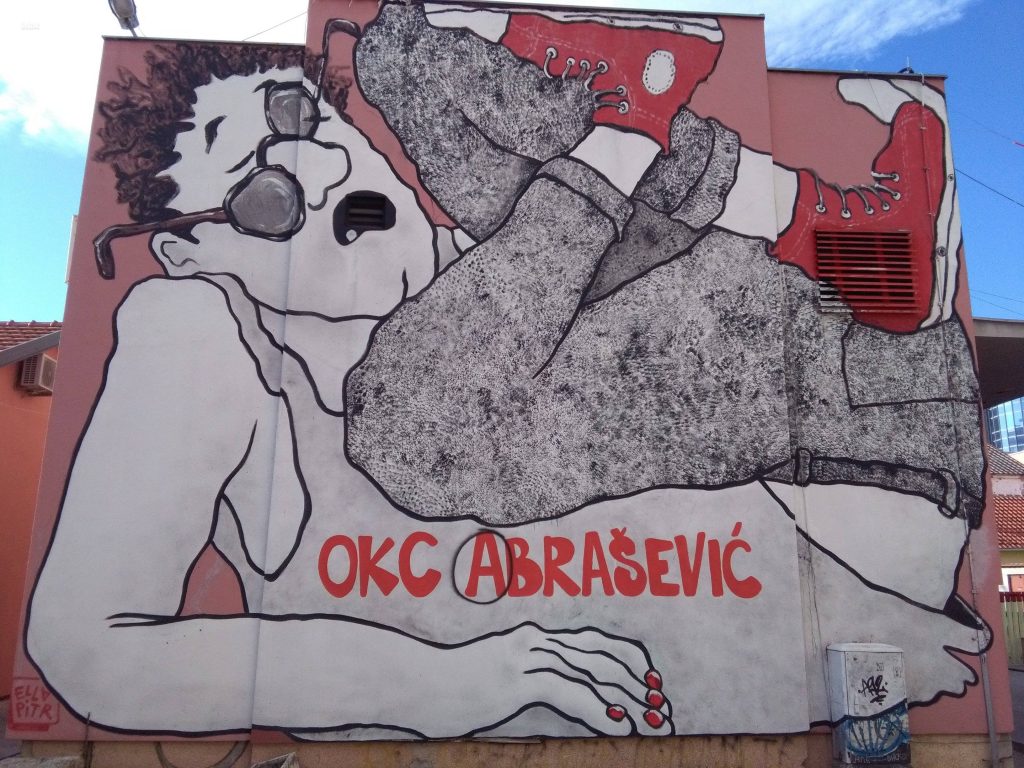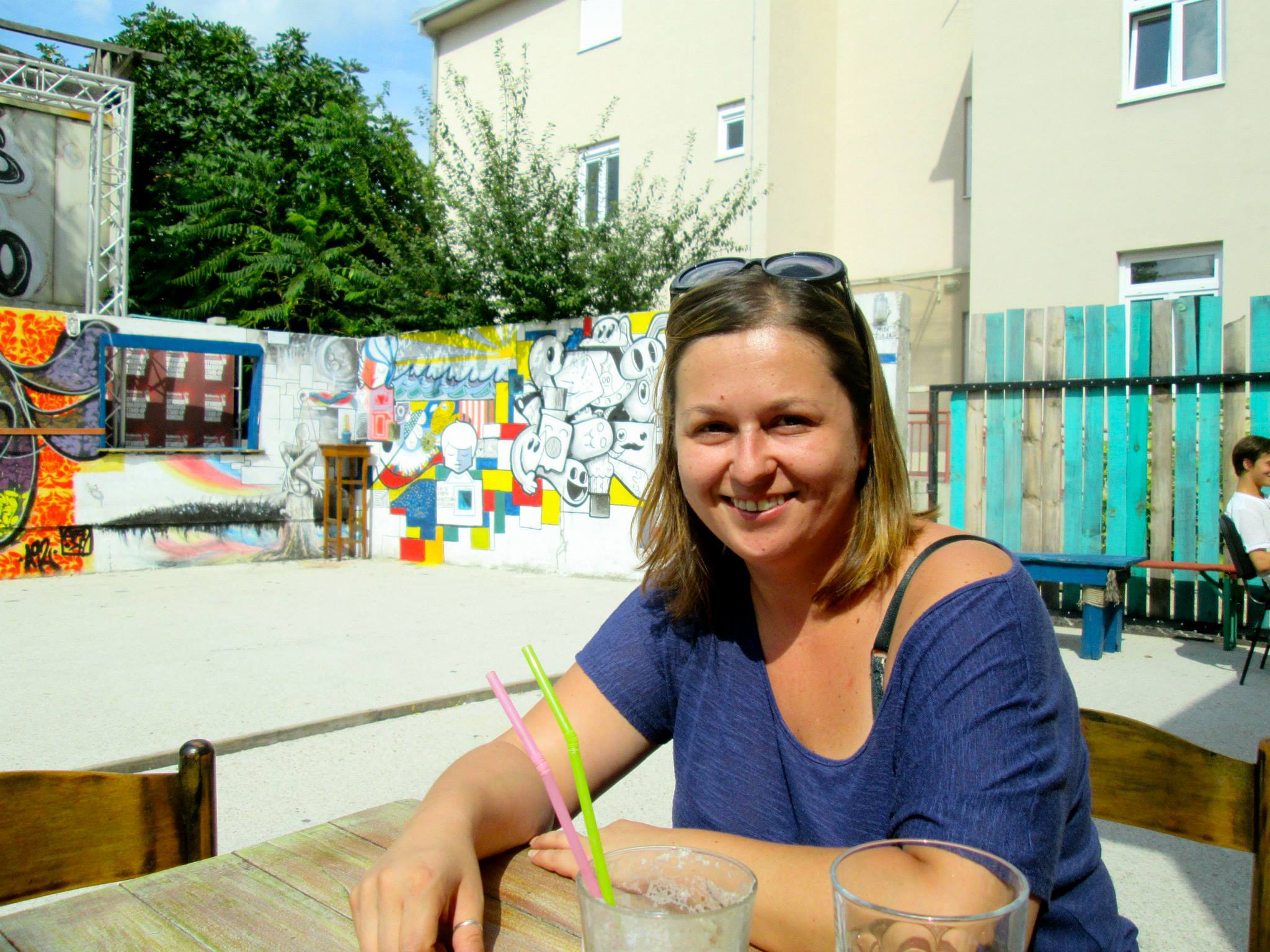How the independent youth cultural centre OKC Abrašević in Mostar bridges the gap between segregated communities in Bosnia and Herzegovina.
„Abrašević is the result of living in a divided city,“ says Kristina Coric (Photo). The 38-year-old woman is one of the driving forces behind the youth cultural centre OKC Abrašević in Mostar. It is a warm evening. The industrial noise trio JIG is playing on the stage at Abrašević. A young man behind the bar is pouring a couple of beers. In the courtyard of the centre people are chatting and enjoying the fresh air. Coric is smoking a cigarette and tells the story of how Abrašević evolved into a meeting point for everybody in Mostar. The famous old bridge of the city is only a short walk away. The old bridge connects the eastern and western part of the city. But the old bridge is first and foremost an attraction for tourists. OKC Abrašević, however, is a bridge that brings together the people of Mostar – especially the youth.
When the Bosnian war ended in 1995, no city in former Yugoslavia was split like Mostar. „The central zone along the Neretva River was destroyed and left alone to discourage the two sides to approach each other,“ Coric remembers the years after the war. When the conflict between Bosnian, Serbian and Croatian forces ended in the mid-90s, the structure of the city had changed. Most of the Bosnian Muslims (49.000) lived on the eastern part, the majority of the Croatian population (47.500) on the western part. Of the about 23.000 Serbs who lived in Mostar before the war, only 1500 remained in the city. Mostar had a hard time healing and little to offer for young people.

„There was not one single place where we could meet,“ says Coric. She and a couple of friends decided to change that. „We wanted to do something and started working for an NGO. It was the first place where we could come together and make things happen.“ Some of Coric’s friends started a poetry society. Others got involved in education. Some got interested in media. The youth scene became visible in the city, mobilized energy and draw attention. The organization of an intercultural festival in 1997 was an important boost in the history of Abrašević. „We had events all over Mostar. People walked around and went to parts of the city they would otherwise not go to.“
To cross from one part to the other, from one neighbourhood to the next, from one place to the other was an important experience in Mostar. „Very often there is no need to explore new places because you have everything in your community,“ she says. The city of Mostar has two sports clubs, two literature clubs, segregated schools, two swimming clubs, two libraries, two administrations and two universities. Two of everything. The opportunities to meet young people from the other side are very rare.

„The festival was great. But once summer was gone and the festival over we were back to square one.“ Kristina and her friends decided to find a permanent place where they could bring their initiatives together and invite the people of Mostar to participate. They found the building of the defunct RKUD Abrašević – a worker’s society that offered arts and educational programmes to citizens throughout the 20th century. RKUD Abrašević was founded in 1926 but was shut down when the war started. Kristina and her friends launched a campaign in 2003 to be able to get permission to use the building. „We were very well prepared and it worked. But we only got the place on an yearly basis which makes it hard to plan and find sponsors.“

An independent youth and cultural centre that does not care about division was not welcomed with open arms by local politicians who often make politics based on ethnic belonging. But OKC Abrašević fought and became the permanent owner of the building in 2008 after a court case. The reason: former members of the old organization RKUD Abrašević declared OKC Abrašević as their legal successor. The city of Mostar had to accept the court ruling and OKC Abrašević was able to start to plan long term.
Since then Kristina and her friends broadened the programme year by year with concerts, festivals, workshops, media training and educational events. Last December, on the 90th anniversary of RKUD Abrašević, they organized a long list of events. One of them was „From us for the City“ – an audio walk in the Abrašević neighbourhood. The participants could download seven short stories on their phones and were given instructions about where to go to listen to the stories. Participants learned about how buildings had changed, neighbourhoods were transformed or what used to happen in certain places in the city.
VIDEO: Hard work – The Beginning of Abrašević
OKC Abrašević’s aim to bring the young people of Mostar together and foster exchange based on respect and solidarity is not an easy task. Nationalist rhetoric, mutual blaming for past atrocities and segregated educational systems make it difficult to overcome prejudices. „I know that it was hard to approach each other right after the war. But we would like to encourage the young ones to get out of their closed communities and understand that Mostar is their city.“
Kristina and her friends are not interested in getting stuck in the past. They are already working on the next step and would like to establish an art gallery next to the concert hall. OKC Abrašević is growing, and continuing to bridge the gap between the people of Mostar.
Working on one community: OKC Abrašević close to the river
The city: Mostar
The largest city in Herzegovina, the southern part of Bosnia and Herzegovina, has about 115,000 inhabitants. During the war about 2,000 people died – civilians and combatants. Ten thousands fled, but the majority came back after the end of the war in the late nineties. Before the war, the Mostar municipality had a population of 43,037 Croats, 43,856 Bosniaks, 23,846 Serbs and 12,768 Yugoslavs. Most of the Serbian population has left the city (around 5,000 remain). Mostar has not held communal elections since 2008 because of arguments concerning the administrative structure of the city practically dividing the city into two parts. Besides OKC Abrašević and the Old Bridge, other places to check out are the partisan memorial, and the Karađoz Bey Mosque. The landscape surrounding Mostar also offers great hiking and rafting opportunities.
The country: Bosnia and Herzegovina
The country declared independence from Yugoslavia on March 3, 1992. The following war killed more than 100,000 people and was ended with the Dayton agreement on December 14, 1995. Since then economic and political progress has been slow. Since the end of the war approximately 150,000 young Bosnians have left the country, and around 10,000 young people still leave the country each year.
In 2016 the unemployment rate was about 25 percent. Youth unemployment was even higher than 65 percent. Bosnia has a population of approximately 3,5 million people with an average salary of around 400 Euro. The political system of the country, which has been based on ethnic identity since the war, is considered to be one of the world’s most complicated systems of government.
